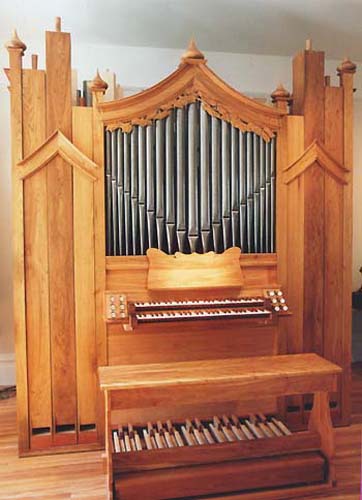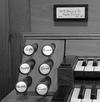A. David Moore Opus 27
San Francisco, California

The joy of owning a house organ has been a lifelong dream. This instrument (Moore Opus 27) of 9 ranks and 10 stops is more than adequate for practicing any music written for organ and for musical performance of most of the organ literature from pre-Sweelinck to post-Dupre. Having known Dave Moore for over 35 years and having greatly admired and respected the integrity and beauty of his work, there was no difficulty deciding to ask him to build the instrument. Together we agreed upon this stoplist:
Pedal
Subbass (stopped wood)
Trumpet (wood and metal)
Great
Clarabella (open wood)
Principal (metal)
Twelfth (metal)
Fifteenth (metal)
Seventeenth (metal)
Positive
Stopt Diapason (wood)
Flute (wood)
Trumpet (wood and metal)
Tremulant to entire organ
Positive to Great
Positive to Pedal
Great to Pedal
The wood used in the organ was cut and milled by Dave Moore on his North Pomfret, Vermont farm. The case is butternut. Other woods used include maple, oak, rosewood, cherry and pine. Cow bone is used for the white keys and stop labels (engraved by Dave himself). Pipe metal has been poured in the Moore workshop and hammered in the manner of dom Bédos. The tremulant is a tremblant doux in the manner of dom Bédos. The trumpet has wooden shallots (one piece with the block) and the resonators are wood in the bass and metal in the treble. 2 3/4 inch wind pressure. The action is suspended. Tuning is Kellner. Builders of the organ are A. David Moore, Thomas Bowen (who also carved the pipe shades) and Thaddeus Stamps.
Some Additional Photos:

Dave Moore at work on opus 27. The Principal of hammered lead/tin is in the display. Visible is the suspended action, also a few of the pedal Trumpet pipes and other partly installed ranks.

The left stop jamb, showing hand inscribed stop knobs, nameplate and other details.
The reader interested in other Moore organs should see instruments in the historic Old North Church in Boston, the United Congregational Church on the Green in New Haven, the Episcopal Church in Boca Grande, Florida (for which instrument Fenner Douglass was consultant), and the Congregational Church on the green in West Haven Connecticut.